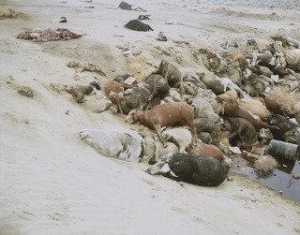Richard Misrach
Richard Misrach
Born: 1949
Biography:
Richard Misrach is an American photographer "firmly identified with the introduction of color to 'fine' photography in the 1970s, and with the use of large-format traditional cameras" (Nancy Princenthal, Art in America).
David Littlejohn of the Wall Street Journal calls Misrach "the most interesting and original American photographer of his generation," describing his work as running "parallel to that of Thomas Struth and Andreas Gursky, two German contemporaries." Littlejohn notes that all three used a large scale color format that defied the expectations of fine art photography at the time.
Misrach is widely recognized as "one of this century’s most internationally acclaimed photographers." He is perhaps best known for his depictions of the deserts of the American west, and for his series documenting the changes brought to bear on the environment by various man-made factors such as urban sprawl, tourism, industrialization, floods, fires, petrochemical manufacturing, and the testing of explosives and nuclear weapons by the military. Curator Anne Wilkes Tucker writes that Misrach's practice has been "driven [by] issues of aesthetics, politics, ecology, and sociology." In a 2011 interview, Misrach noted: "My career, in a way, has been about navigating these two extremes - the political and the aesthetic." Describing his philosophy, Tracey Taylor of the New York Times writes that "[Misrach's] images are for the historical record, not reportage."
Misrach has been married since 1989 to writer Myriam Weisang and has a son, Jake, from his first marriage to Debra Bloomfield.
Misrach was born in 1949 in Los Angeles, California. In 1967 he left Los Angeles for the University of California, Berkeley, where he obtained a B.A. in Psychology after briefly pursuing a degree in Mathematics. While on campus he was confronted with the anti-war riots and began photographing the events around him; he also learned the rudiments of photography with Paul Herzoff, Roger Minick, and Steve Fitch at the ASUC Berkeley Studio.
Misrach's first major photography project, completed in 1974, depicted homeless residents of Telegraph Avenue in Berkeley, California. This suite of photographs was shown at the International Center of Photography and published as a book, Telegraph 3 AM, which won a Western Book Award in 1975.
Having hoped that Telegraph 3 AM would help improve life on the streets, Misrach was frustrated by the book's minimal impact and retreated to the deserts of Southern California, Arizona, and Baja California, where he took photographs devoid of human figures entirely. Working at night with a strobe that illuminated the landscape around him, he experimented with unusual printing techniques in the university darkroom and created richly hued, split-toned silver prints. A resulting 1979 book was published without a title or a single word of accompanying text besides nominal identifying information on the book's spine. In 1976 he traveled to Stonehenge to continue his split-toned night studies, and in 1978 he began working in color on journeys to Greece, Louisiana, and Hawaii.
As Misrach's longest-running and most ambitious project, the Desert Cantos, an ongoing series of photographs of deserts, may be considered the photographer’s magnum opus. Begun in 1979 with a Deardorff 8×10” view camera, the series is ongoing and numbers 39 cantos as of 2017.
Misrach's use of the term "canto" was inspired in part by the cantos of Ezra Pound; in a 1989 article in Creative Camera, Gerry Badger elaborates:
The Italian term "canto" was used to denote that the vast enterprise has been broken down into individual thematic essays or "cantos," which together make up the whole work, or "song cycle." Some of these cantos consist of only a few images, while others run into hundreds. Some may be regarded as "documentary" in mode, some more metaphorical. Some may be considered aesthetic in intent, some "political" – though as an ambitious and intelligent photographer, aesthetics are never pursued at the expense of politics, or vice versa. Misrach’s goal may be said to be a search for the photographic Holy Grail, to fuse reportage with poetry. To progress – as he put it – "from the descriptive and the informative to a metaphorical resolution."
A 2013 review in Architectural Digest compares Misrach's desert images to the work of "Carleton Watkins, Timothy O’Sullivan, and other 19th-century itinerant photographers," noting that while "sublimely beautiful, Misrach’s prints are also imbued with disquieting undercurrents." Beginning with "The Terrain," in which images of apparently untouched wilderness are punctuated by human elements such as a lone telephone pole or a train, the Cantos include spectacles like the space shuttle landing ("The Event") and car racing ("The Salt Flats"), man-made fires and floods like the Salton Sea ("The Flood") and desert seas created by the damming of rivers, as well as color-field studies of empty skies ("The Skies"). Images of military training and testing sites feature extensively in the Cantos and the series' corresponding publications: "The War" resulted in the 1991 book Bravo 20: The Bombing of the American West, co-authored by Myriam Weisang Misrach, and nuclear testing was addressed in Violent Legacies, published in 1992. "The Pit" documented mass graves of dead animals in the Nevada desert while "Pictures of Paintings" focused on the representation of the western landscape in museums across the American West. "The Playboys" depicted issues of Playboy, discovered by the photographer at a military site, that had been used for target practice.
More...
Wikipedia link: Click Here





